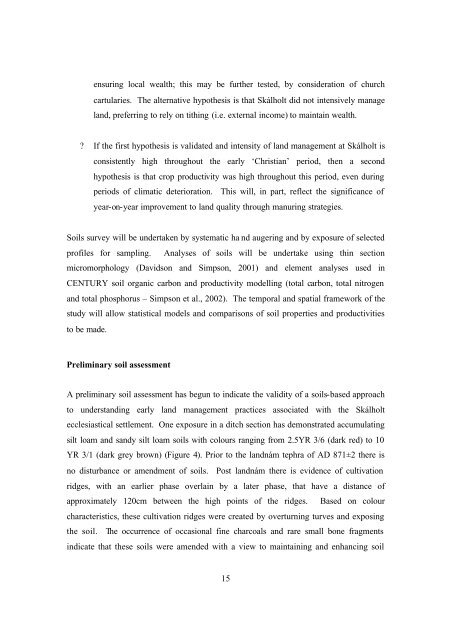Skáholt 2002 - Nabo
Skáholt 2002 - Nabo
Skáholt 2002 - Nabo
Create successful ePaper yourself
Turn your PDF publications into a flip-book with our unique Google optimized e-Paper software.
ensuring local wealth; this may be further tested, by consideration of church<br />
cartularies. The alternative hypothesis is that Skálholt did not intensively manage<br />
land, preferring to rely on tithing (i.e. external income) to maintain wealth.<br />
If the first hypothesis is validated and intensity of land management at Skálholt is<br />
consistently high throughout the early ‘Christian’ period, then a second<br />
hypothesis is that crop productivity was high throughout this period, even during<br />
periods of climatic deterioration. This will, in part, reflect the significance of<br />
year-on-year improvement to land quality through manuring strategies.<br />
Soils survey will be undertaken by systematic ha nd augering and by exposure of selected<br />
profiles for sampling. Analyses of soils will be undertake using thin section<br />
micromorphology (Davidson and Simpson, 2001) and element analyses used in<br />
CENTURY soil organic carbon and productivity modelling (total carbon, total nitrogen<br />
and total phosphorus – Simpson et al., <strong>2002</strong>). The temporal and spatial framework of the<br />
study will allow statistical models and comparisons of soil properties and productivities<br />
to be made.<br />
Preliminary soil assessment<br />
A preliminary soil assessment has begun to indicate the validity of a soils-based approach<br />
to understanding early land management practices associated with the Skálholt<br />
ecclesiastical settlement. One exposure in a ditch section has demonstrated accumulating<br />
silt loam and sandy silt loam soils with colours ranging from 2.5YR 3/6 (dark red) to 10<br />
YR 3/1 (dark grey brown) (Figure 4). Prior to the landnám tephra of AD 871±2 there is<br />
no disturbance or amendment of soils. Post landnám there is evidence of cultivation<br />
ridges, with an earlier phase overlain by a later phase, that have a distance of<br />
approximately 120cm between the high points of the ridges. Based on colour<br />
characteristics, these cultivation ridges were created by overturning turves and exposing<br />
the soil. The occurrence of occasional fine charcoals and rare small bone fragments<br />
indicate that these soils were amended with a view to maintaining and enhancing soil<br />
15
















